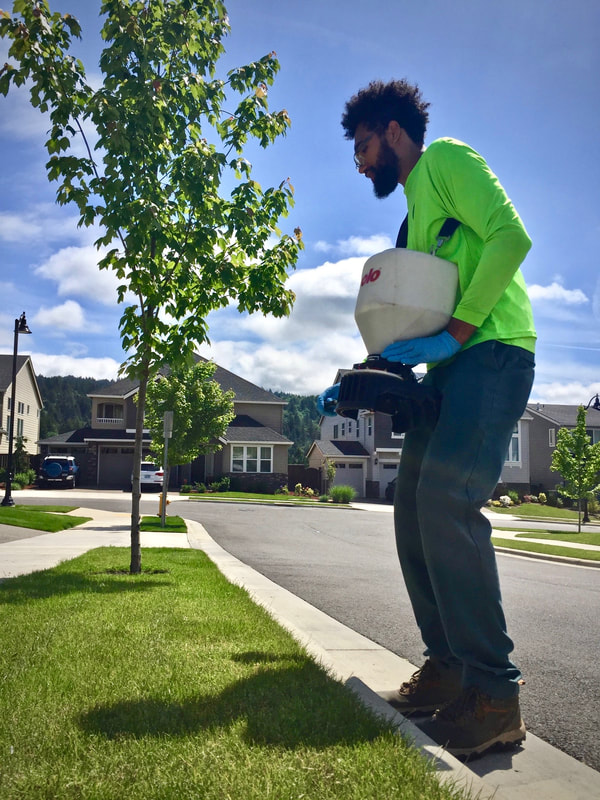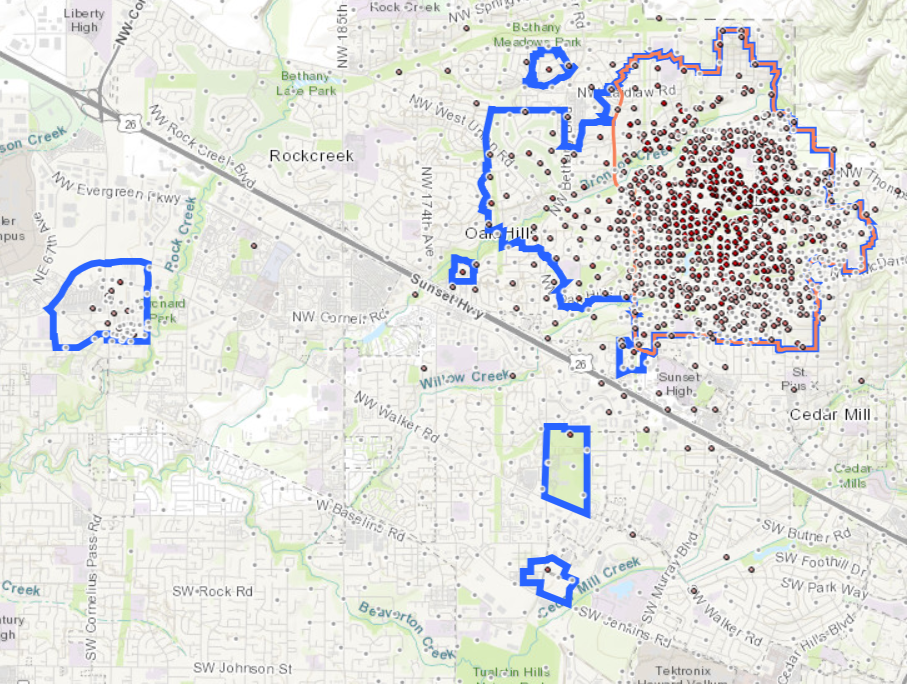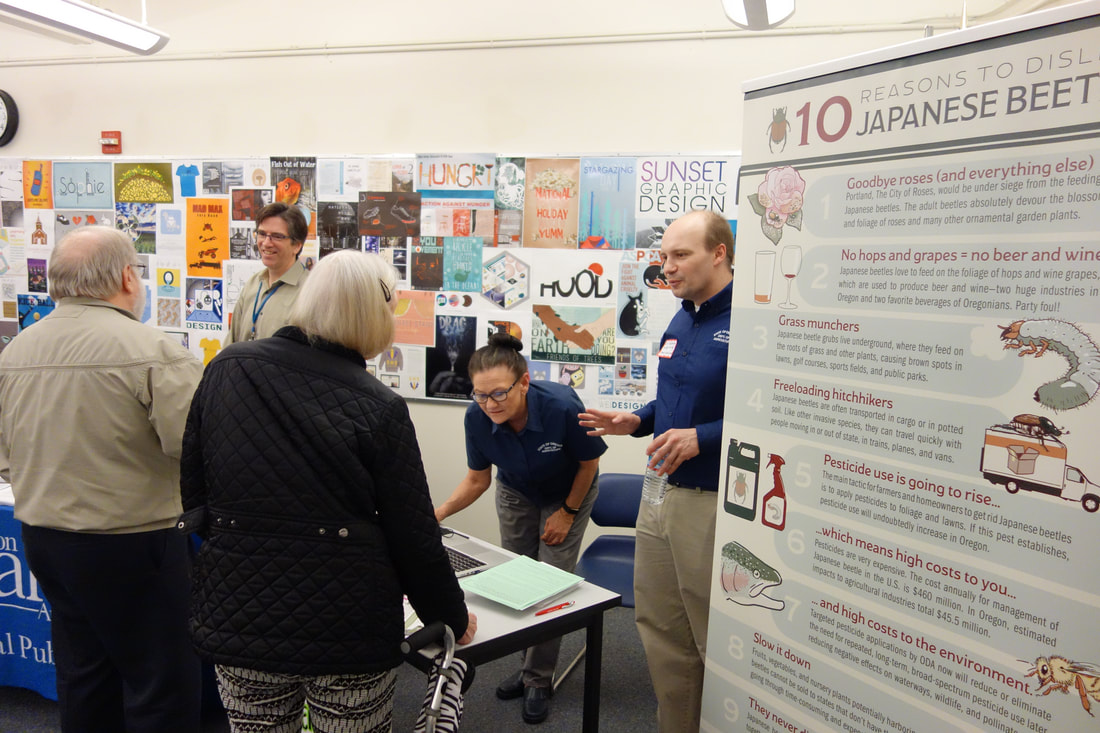|
To all first-time site visitors: welcome! And thank you for reading more about this important project to protect Oregon’s agricultural economy and natural resources.
Here is a quick update on decisions made in the last few months In the summer of 2018, Oregon Department of Agriculture (ODA)’s traps caught over 17,000 Japanese beetles. Treatments in 2017 reduced the 2018 Japanese beetle populations by approximately 34%. In response, this past winter the Japanese beetle project team has been busy analyzing the detections and meeting with partners to create a strategy for 2019. The beetle battle is in high gear! Based on the information collected, the project is moving in the right direction with a lot of work ahead. A third year of treatment is proposed for 2019 with an expanded boundary to treat new areas where beetles have been found. The treatment will happen in March, April, and May using the same larvicide, Acelepryn G. Acelepryn G will be broadcast in the form of small granules over irrigated turf grass and ornamental beds of all properties in the designated treatment area in Washington County. In areas where the largest concentration of beetles were found last year, ODA may need to do a smaller targeted application of Acelepryn later in the summer to increase effectiveness of the treatment. Note: if you are in the area identified as needing an additional treatment, you will receive official notice by mail. How to help This is the state’s largest Japanese beetle eradication effort. There are multiple ways that you can help. Required
If you have questions or concerns, please look over our extensive Frequently Asked Questions about the project. Still have questions? Contact the ODA team. [Category tags: Consent, Community Engagement, Larvicide - Acelepryn, Residents, Updates, Treatment, Washington County] Community Open House A drop-in style, open house was held at Sunset High School on Tuesday, February 19th. Attendees who came were able to ask questions of the expert team leading and supporting the project. Info Session: Japanese beetle in Washington County An online information session was held on Wednesday, February 13th. The Oregon Department of Agriculture welcomes your questions and comments. Find out how to contact the project team by visiting our Contact Page.
*Edited February 22, 2019 to include up-to-date opportunities to learn more. [Category Tags: Beetles in Oregon, Community Engagement, Japanese Beetle Basics, Japanese Beetle Threats, Larvicide - Acelepryn, Quarantine, Treatment, Yard Debris] PLEASE NOTE: THIS POST IS AN ARCHIVE FROM THE 2017-2018 PROJECT YEAR. Second Treatment Wrapping Up in 2018 Thank you to residents and land managers in Washington County (Cedar Mill, Bethany and Oak Hills) and Oakland area that have been helping the Oregon Department of Agriculture beat the Japanese beetle! The Oregon Department of Agriculture (ODA) is currently wrapping up a second treatment in year two of the Japanese beetle eradication project. Support from resident in the area has been very positive. Before treatment, the ODA received over 5,000 responses from residents allowing ODA and their staff to treat the properties, including 30 Homeowners Associations supporting treatment in common areas. Tualatin Hills Parks and Recreation Department and the Beaverton School District are also supporting the project and allowing treatment to parks and school fields. Applicator crews have said that residents in the area are expressing their support for the project, with many "Thank you’s" and "Get those beetles!". Thank you to all of the residents who are working with us to protect Oregon’s plants and agriculture from this invasive species! Summary of the 2018 Treatment The ODA continued their relationship with General Tree Service to apply the same treatment as last year, a granular pesticide called Acelepryn G® which is a targeted larvicide that kills certain pests in their larval state in the soil. The granules are broadcasted on lawns and other landscaped areas, then it breaks down into the soil when it is watered in through rain or sprinklers. This pesticide is a “reduced risk” pesticide and is not considered a health threat for humans, pets, and other insects that don’t go through a larvae stage in treatment areas. According to the label, “Acelepryn G is recommended for Integrated Pest Management programs on turf and landscape ornamentals because it does not directly impact natural arthropod predator and parasitoid populations including ladybird beetles (aka ‘ladybugs’).” Since the treatment targets certain pest larvae in the soil, the treatment with Acelepryn G® has no adverse effects on pollinators when applied according to the label instructions. For more treatment & health information, please visit our Treatment page. A snapshot of the treatment area in Washington County
While there have been some delays due to weather, treatment has been able to be completed as scheduled due in large part to the hard work by application crews. A big shout out to the crews members and crew leads who are working long days, rain or shine, to make sure treatment is done correctly and on time. PLEASE NOTE: THIS POST IS AN ARCHIVE FROM THE 2017-2018 PROJECT YEAR.
2018 Treatment Information For Residents in the Japanese Beetle Treatment Area in Cedar Mill and nearby Neighborhoods Treatment may take place anytime between 8am and 5pm. There is just one treatment per property or residence scheduled for 2018. The treatment for Japanese beetles will be done by a professional, licensed pesticide applicator under contract with the Oregon Department of Agriculture (ODA). An observer from ODA will be also be present during treatment. Only lawns and ornamental planting beds will be treated. Vegetable gardens, berry bushes, and other edible plants will not be treated. This treatment consists of the application of Acelepryn G granular larvicide to lawns or ornamental planter beds. This will take approximately 15 minutes or less; most properties done in about 5 minutes or less. You do not need to be home or present for the application. If you will not be home, please see instructions below about how to prepare your residence for the treatment. The scheduled time above is weather dependent. If it is too rainy on the day of scheduled treatment, we will notify you of the rescheduled date as soon as possible. Very rainy weather or saturated soil increases the risk of the product being washed off the surface quickly and not entering the soil. Normal to light rain is OK. Information from the Oregon Health Authority about Acelepryn G can be found at http://oda.direct/jbhealth Before the treatment On or prior to the morning of treatment, please make sure that: 1. Your property is accessible to the contractor’s crew. We need to treat front and backyards. All applicable outside gates and entryways should be unlocked. Animals must be kept inside for the safety of our crew. 2. Non-stationary items that can be easily moved should be removed from lawns and grassy areas. 3. Water and food bowls for pets should be removed or covered during application. 4. Adults, children and pets of all kinds should remain inside during the application so as not to interfere with personnel conducting the treatment. The application should take 15 minutes or less to complete. After the treatment To get the Acelepryn G near the grass roots to be effective against root-feeding grubs, we ask you to water your lawn for 5-10 minutes at your earliest convenience. If it has rained during or following application, it is not necessary to water it in. Keep children and pets off the treated area as long as granules are still visible. Inspect walkways and patios, and sweep-up or pick up stray granules (after putting on gloves). Granules are supposed to be watered in, as instructed by ODA. Keep off of the treated area until the granules are completely watered in and the lawn has dried. The area is then immediately safe to re-enter. Please do not hesitate to contact ODA with any questions or concerns by phoning 1-800-525-0137 or emailing the project coordinator Chris Hedstrom at [email protected]. PLEASE NOTE: THIS POST IS AN ARCHIVE FROM THE 2017-2018 PROJECT YEAR.
PLEASE NOTE: Three mailers have been sent to residents in the Cedar Mill treatment area: 1) a consent form, 2) a postcard with your correct PIN to use for online entry, and 3) a reminder postcard. The Oregon Department of Agriculture is currently posting notices on the doors of residents who have not responded. Find out if you are in the Cedar Mill treatment area, visit: www.japanesebeetlepdx.info/treatment Return you Consent Form NOW Consent forms from the Oregon Department of Agriculture have been mailed to residents in the proposed 2018 Cedar Mill treatment area. To return your form, you can either: 1) Submit your forms online using a Personal Identification Number (PIN) at the website: http://oda.direct/JBconsent 2) Download the consent form (DOWNLOAD PDF HERE) and return by email. Treatment for Japanese beetle begins on April 2nd, 2018. Please return your consent form right away. Thank you for your cooperation. Please contact ODA directly with any questions, email us [email protected] or call us at 1-800-525-0137. Edited March 20, 2018 with updated information about ways to return a consent form. PLEASE NOTE: THIS POST IS AN ARCHIVE FROM THE 2017-2018 PROJECT YEAR.
On March 5th, 2018, ODA staff will be at the Cedar Mill Community Library 12505 NW Cornell Road Suite 13 Portland, Oregon 97229-5688 from 5:15 pm – 7:15 pm to answer questions about the project. You can also drop off consent forms or fill them out in person. If you received a notice that the deadline for consent form returns is February 28th but would like to attend the event, we recommend that you bring the form to the event or contact the project coordinator at 503-986-4654. |
Header photograph by Whitney Cranshaw, bugwood.org
Categories
All
Archives
January 2024
|
|
This website is intended to provide readers with information that has been peer reviewed and produced from transparent and accountable sources. The Oregon Department of Agriculture is the lead agency for this project and maintains this website.
|
© COPYRIGHT 2018. ALL RIGHTS RESERVED.




 RSS Feed
RSS Feed
